BLOG - Page 45
Deprecated: strtolower(): Passing null to parameter #1 ($string) of type string is deprecated in /var/www/vhosts/moontrix.com/essenthouse.com/_blog.php on line 99
Recently created mixtures:

Sea-Buckthorn Macerated oil
February 7, 2019

Home made air freshener
June 29, 2016

Homemade Dog-rose distillate
June 28, 2016

Homemade jasmine distillate
June 22, 2016

Moxibustion treatment with Moxa stick
May 30, 2016

Face and body gentle oil cleanser
May 26, 2016
BLOG / LATEST ADDITIONS!
Roman Chamomile Distillate (Chamaemelum Nobile) ☸ Herbal distillates ☸ Base / General
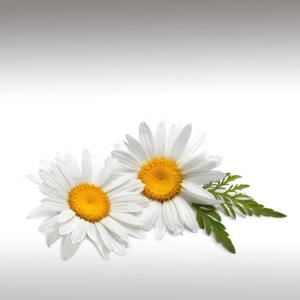
 Chamaemelum nobile, commonly known as chamomile (also spelled camomile),
Roman chamomile, English chamomile, garden chamomile, ground apple, low
chamomile, or whig plant, is a low perennial plant found in dry fields
and around gardens and cultivated grounds in Europe, North America, and
Argentina. C. nobile is, along with Matricaria chamomilla, an important
source of the herbal product known as chamomile.
Chamaemelum nobile, commonly known as chamomile (also spelled camomile),
Roman chamomile, English chamomile, garden chamomile, ground apple, low
chamomile, or whig plant, is a low perennial plant found in dry fields
and around gardens and cultivated grounds in Europe, North America, and
Argentina. C. nobile is, along with Matricaria chamomilla, an important
source of the herbal product known as chamomile.
The plant is used to flavor foods, in herbal teas, perfumes, and cosmetics. It is used to make a rinse for blonde hair, and is popular in aromatherapy; its practitioners believe it to be a calming agent to reduce stress and aid in sleep.An organic food information site considers chamomile to be an antiseptic, antibiotic, disinfectant, bactericidal and vermifuge.Roman chamomile is not recommended for use during pregnancy as it can cause uterine contractions and miscarriage.
Submitted by OperaDreamhouse (March 13, 2014)
Damask Rose Distillate (Rosa Damascena) ☸ Herbal distillates ☸ Base / General
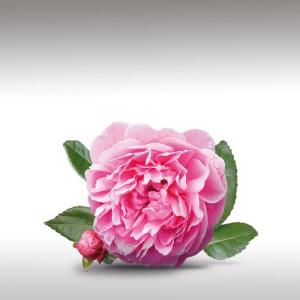

According to Indian legend, the palace gardens belonging to the Mughal Emperor Jahangir featured canals that flowed with Rose Water. One day, his favorite sultana requested that the foam that floated in the canals be removed. The foam gave off the most incomparablefragrance, and the sultana thought it was the most intoxicating scent she had ever smelled. Thus Rose Distillation was born.
Rosa Damascena, more commonly known as the Damask Rose, or sometimes as the Rose of Castile, is a Rose hybrid, derived from Rosa Gallica and Rosa Moschata. Further DNA analysis has shown that a third species, Rosa Fedtschenkoana, is associated with the Damask Rose.
Rosa Damascena is a cultivated flower, no longer found growing wild, and the history of just where it came from is varied, but generally understood as coming from the Middle East.
The Crusader Robert de Brie is sometimes given credit for bringing the Damask Rose from Syria to Europe sometime between 1254 and 1276. The name refers to Damascus, Syria a major city in the Middle Eastern region.
Rosa Damascena, more commonly known as the Damask Rose, or sometimes as the Rose of Castile, is a Rose hybrid, derived from Rosa Gallica and Rosa Moschata. Further DNA analysis has shown that a third species, Rosa Fedtschenkoana, is associated with the Damask Rose.
Rosa Damascena is a cultivated flower, no longer found growing wild, and the history of just where it came from is varied, but generally understood as coming from the Middle East.
The Crusader Robert de Brie is sometimes given credit for bringing the Damask Rose from Syria to Europe sometime between 1254 and 1276. The name refers to Damascus, Syria a major city in the Middle Eastern region.
Other stories say the Romans brought the Rose to England, and a third account says that the physician of Henry VIII gave him a Damask Rose, as a present, around 1540.
The Damask Rose is a deciduous shrub growing to 2,2 metres tall, the stems densely armed with stout, curved prickles and stiff bristles. The Roses are a light to moderate pink to light red. The relatively small flowers grow in groups. The bush has an informal shape.
Gathering the flowers is quite labor - intensive as it must be done by hand. There are about twenty to forty days per year when harvesting occurs, depending on the type of Rosa Damascena cultivation in the region. The Roses are gathered by hand and brought to a central location for steam distillation.
The largest producers of Rose oil from the different names all falling under the name Rosa Damascena are Bulgaria and Turkey. France and India also contribute significantly to the world market. Morocco, Tunisia and some other Middle Eastern countries have historically produced Rose oil, but their modern contribution is minimal.
The town of Kazanlak in Bulgaria was founded in 1420. It is assumed by most historians that the cultivation of the Kazanlak Rose began around that period. Kazanlak called the “Valley of Roses". The distillate from these Roses is sold as "Bulgarian Rose Oil”, and “Bulgarian Rose Otto”. A nearby valley provided the perfect environment for growing Roses, thereby establishing what would in later years become the finest Rose oil producing region in the world.
In Bulgaria, the rose blossoms of Rosa Damascena begin to bloom around the third week of May, and will continue for three or four weeks depending upon climatic conditions. The concentration of perfume and constituents is at its greatest just as the flowers develop into full bloom, it is at this point when it is best to harvest. The expanded flowers should be gathered before sunrise and with the calyx attached so as to gain the maximum amount of volatile oils.
In Bulgaria during the early 1900's, virtually all Rose oil was distilled on-site using direct-fire stills operated by the farmers. A suitable site would be chosen adjacent to the field and near a stream and the apparatus would be set up.
Bulgaria region distillation method:
Once the Rose petals are gathered for the day, they are laid out for a group of women to sift through, taking out any leaves, ensuring that only the Rose Petals go into the stills. Once the correct amount of Rose Petals is placed into the still, pure mountain stream Water is added, three parts by weight of Water to one part of Roses. Then the mixture is gently boiled for four hours as steam is passed off and condensed into another container, as Rose Water.
Modern stills are made of copper and are heated with an open wood fire from below. The Roses can not be distilled in the usual way by directly injecting steam, because the petals compact to form a large mass that the steam can not penetrate. Therefore the distillation techniques have been refined in various ways to overcome this problem.
During distillation a large amount of oil is absorbed into the distillation Water, and this is known as the "First Water". The Rose oil must be recovered from this water to produce an acceptable yield, and this is achieved by skilfully re - distilling the water to separate the oil, a process known as cohobation.
The total yield of oil will depend upon several conditions: climate, the time of the harvest, condition of the flowers and the method of distillation. During the middle of the harvest period the yield is higher than at the beginning, and mild weather will result in a further increase in the oil produced.
On average, Rosa Damascena will yield 1 kilo of oil per 4,000 kilos of flowers using modern distillation processes.
For centuries, the Damascus Rose (Rosa Damascena) has been considered a symbol of beauty and love. The fragrance of the rose has been captured and preserved in the form of rose water by a method that can be traced back to ancient times in the Middle East, and later to the Indian subcontinent. A Persian scientist, Avicenna, is credited with the invention of the process for extracting rose water from rose petals in the early 11th century.
Rose Water preceded the discovery of rose oil and was used for centuries before the oil or "attar" was first produced.
The exact origin of Rose Water and Rose oil production was never recorded in history. However, the existence of Rose Water as far back as 1200 BC to the Mycenaean city of Pilos where it was traded commercially. The production of Rose Water was also a thriving industry in Shiraz in Persia. From 810 BC the province of Faristan in Persia was required to give an annual tribute of 30,000 bottles of Rose Water to the Caliph in Baghdad. At this time Faristan was the centre of global Rose Water production, exporting to China and throughout the Islamic world.
Today there are four main centres in the world where Roses are grown for the production of Rose Water and Rose oil. They are Kazanluk, known as "The Valley of Roses" in Bulgaria, Isparta in Turkey, Shiraz in Iran and Grasse in the South of France. Each of these regions has its own particular climate and process of distillation.
The Damask Rose is a deciduous shrub growing to 2,2 metres tall, the stems densely armed with stout, curved prickles and stiff bristles. The Roses are a light to moderate pink to light red. The relatively small flowers grow in groups. The bush has an informal shape.
Gathering the flowers is quite labor - intensive as it must be done by hand. There are about twenty to forty days per year when harvesting occurs, depending on the type of Rosa Damascena cultivation in the region. The Roses are gathered by hand and brought to a central location for steam distillation.
The largest producers of Rose oil from the different names all falling under the name Rosa Damascena are Bulgaria and Turkey. France and India also contribute significantly to the world market. Morocco, Tunisia and some other Middle Eastern countries have historically produced Rose oil, but their modern contribution is minimal.
The town of Kazanlak in Bulgaria was founded in 1420. It is assumed by most historians that the cultivation of the Kazanlak Rose began around that period. Kazanlak called the “Valley of Roses". The distillate from these Roses is sold as "Bulgarian Rose Oil”, and “Bulgarian Rose Otto”. A nearby valley provided the perfect environment for growing Roses, thereby establishing what would in later years become the finest Rose oil producing region in the world.
In Bulgaria, the rose blossoms of Rosa Damascena begin to bloom around the third week of May, and will continue for three or four weeks depending upon climatic conditions. The concentration of perfume and constituents is at its greatest just as the flowers develop into full bloom, it is at this point when it is best to harvest. The expanded flowers should be gathered before sunrise and with the calyx attached so as to gain the maximum amount of volatile oils.
In Bulgaria during the early 1900's, virtually all Rose oil was distilled on-site using direct-fire stills operated by the farmers. A suitable site would be chosen adjacent to the field and near a stream and the apparatus would be set up.
Bulgaria region distillation method:
Once the Rose petals are gathered for the day, they are laid out for a group of women to sift through, taking out any leaves, ensuring that only the Rose Petals go into the stills. Once the correct amount of Rose Petals is placed into the still, pure mountain stream Water is added, three parts by weight of Water to one part of Roses. Then the mixture is gently boiled for four hours as steam is passed off and condensed into another container, as Rose Water.
Modern stills are made of copper and are heated with an open wood fire from below. The Roses can not be distilled in the usual way by directly injecting steam, because the petals compact to form a large mass that the steam can not penetrate. Therefore the distillation techniques have been refined in various ways to overcome this problem.
During distillation a large amount of oil is absorbed into the distillation Water, and this is known as the "First Water". The Rose oil must be recovered from this water to produce an acceptable yield, and this is achieved by skilfully re - distilling the water to separate the oil, a process known as cohobation.
The total yield of oil will depend upon several conditions: climate, the time of the harvest, condition of the flowers and the method of distillation. During the middle of the harvest period the yield is higher than at the beginning, and mild weather will result in a further increase in the oil produced.
On average, Rosa Damascena will yield 1 kilo of oil per 4,000 kilos of flowers using modern distillation processes.
For centuries, the Damascus Rose (Rosa Damascena) has been considered a symbol of beauty and love. The fragrance of the rose has been captured and preserved in the form of rose water by a method that can be traced back to ancient times in the Middle East, and later to the Indian subcontinent. A Persian scientist, Avicenna, is credited with the invention of the process for extracting rose water from rose petals in the early 11th century.
Rose Water preceded the discovery of rose oil and was used for centuries before the oil or "attar" was first produced.
The exact origin of Rose Water and Rose oil production was never recorded in history. However, the existence of Rose Water as far back as 1200 BC to the Mycenaean city of Pilos where it was traded commercially. The production of Rose Water was also a thriving industry in Shiraz in Persia. From 810 BC the province of Faristan in Persia was required to give an annual tribute of 30,000 bottles of Rose Water to the Caliph in Baghdad. At this time Faristan was the centre of global Rose Water production, exporting to China and throughout the Islamic world.
Today there are four main centres in the world where Roses are grown for the production of Rose Water and Rose oil. They are Kazanluk, known as "The Valley of Roses" in Bulgaria, Isparta in Turkey, Shiraz in Iran and Grasse in the South of France. Each of these regions has its own particular climate and process of distillation.
Submitted by OperaDreamhouse (March 13, 2014)
Frankincense Distillate (Boswellia Serrata) ☸ Herbal distillates ☸ Base / General
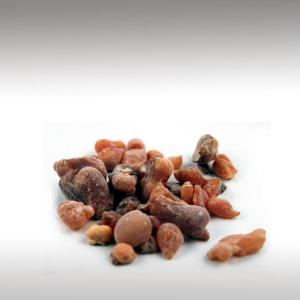
 Frankincense, also called Olibanum, is an aromatic resin obtained from
trees of the genus Boswellia, particularly Boswellia Sacra, Boswellia Carteri, Boswellia Thurifera, Boswellia Frereana and Boswellia Bhaw-Dajiana (Burseraceae). The English word is derived from Old French
"Franc Encens" and is used in incense and perfumes.
Frankincense, also called Olibanum, is an aromatic resin obtained from
trees of the genus Boswellia, particularly Boswellia Sacra, Boswellia Carteri, Boswellia Thurifera, Boswellia Frereana and Boswellia Bhaw-Dajiana (Burseraceae). The English word is derived from Old French
"Franc Encens" and is used in incense and perfumes.There are four main species of Boswellia that produce true Frankincense and resin from each of the four is available in various grades. The grades depend on the time of harvesting. The resin is hand-sorted for quality. Frankincense can also be found in the Bible as one of the three gifts the wise men gave to the young child Jesus.
This powerful Hydrosol is used in skin care, meditation, energetics work, fragrance blends, and other aromatherapy preparations. Frankincense Distillate has a fresh scent that is resinous and sweet with woody undertones. It has aroma notes that are similar to both the resin tears and the essential oil.
Blending possibilities are endless depending on your intended use. Aromatically, this Hydrosol will blend well with blood orange, lavandin, douglas fir, and neroli hydrosols. It also makes a wonderful base for citrus, resin, flower, and woodsy tree essential oils.
Submitted by OperaDreamhouse (March 13, 2014)
☸ ☸ Base / General
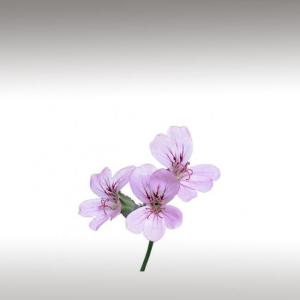

The true Pelargonium graveolens is an uncommon species in the
Pelargonium genus, which is native to South Africa, Zimbabwe and
Mozambique, while the plants cultivated under this name differ from the
wild specimens and are of hybrid origin.
Often called a geranium, as it falls within the plant family Geraniaceae, and was previously categorised under the same genus. The common Pelargonium 'Graveolens' or Pelargonium 'Rosat' has great importance in the perfume industry. It is cultivated on a large scale and its foliage is distilled for its scent. Pelargonium 'Graveolens' cultivars have a wide variety of smells, including rose, citrus, mint, coconut and nutmeg, as well as various fruits. However, the most commercially important varieties are those with rose scents.
Often called a geranium, as it falls within the plant family Geraniaceae, and was previously categorised under the same genus. The common Pelargonium 'Graveolens' or Pelargonium 'Rosat' has great importance in the perfume industry. It is cultivated on a large scale and its foliage is distilled for its scent. Pelargonium 'Graveolens' cultivars have a wide variety of smells, including rose, citrus, mint, coconut and nutmeg, as well as various fruits. However, the most commercially important varieties are those with rose scents.
Submitted by OperaDreamhouse (March 13, 2014)
Narrow-Leaved Tea-Tree Distillate (Melaleuca Alternifolia) ☸ Herbal distillates ☸ Base / General
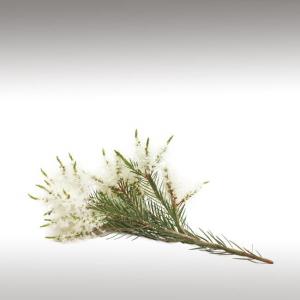
 Melaleuca Alternifolia, commonly known as
Narrow-leaved Paperbark, Narrow-leaved Tea-tree, Narrow-leaved Ti-tree,
or Snow-in-summer, is a species of tree or tall shrub in the plant genus
Melaleuca. Native to Australia, it occurs in Southeast Queensland and
the north coast and adjacent ranges of New South Wales.
Melaleuca Alternifolia, commonly known as
Narrow-leaved Paperbark, Narrow-leaved Tea-tree, Narrow-leaved Ti-tree,
or Snow-in-summer, is a species of tree or tall shrub in the plant genus
Melaleuca. Native to Australia, it occurs in Southeast Queensland and
the north coast and adjacent ranges of New South Wales. It grows along streams and on swampy flats, and is often the dominant species where it occurs.
The indigenous Bundjalung people of eastern Australia use "Tea Trees" as a traditional medicine by inhaling the oils from the crushed leaves to treat coughs and colds. They also sprinkle leaves on wounds, after which a poultice is applied. In addition, Tea Tree leaves are soaked to make an infusion to treat sore throats or skin ailments.
Submitted by OperaDreamhouse (March 13, 2014)
Damask Rose Essential Oil (Rosa Damascena) ☸ Essential oils ☸ Base / General
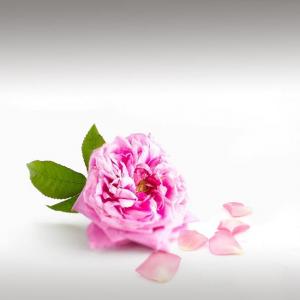

Botanical Name: Rosa damascena
Common Method of Extraction: Steam distilled
Part Typically Used: The petals of various types of rose
Color: Light to mid yellow. Pale yellow or greenish tint
Consistency: Thin
Perfumery Note: Top/Middle
Strength of Initial Aroma: Deep, sweet, floral, with touch of low citrus, sensual, rosy, strong.
Rosa Damascena, more commonly known as the Damask Rose, or sometimes as the Rose of Castile, is a Rose hybrid, derived from Rosa Gallica and Rosa Moschata. Further DNA analysis has shown that a third species, Rosa Fedtschenkoana, is associated with the Damask Rose.
The flowers are renowned for their finefragrance, and are commercially harvested for Rose oil (either "Rose Otto" or "Rose Absolute") used in perfumery and to make rose water and "Rose Concrete". The flower petals are also edible.
They may be used to flavor food, as a garnish, as an herbal tea, and preserved in sugar as gulkand. The Damask Rose is a deciduous shrub growing to 2,2 metres tall, the stems densely armed with stout, curved prickles and stiff bristles. The leaves are pinnate, with five leaflets. The Roses are a light to moderate pink to light red.
The relatively small flowers grow in groups. The bush has an informal shape. It is considered an important type of Old Rose, and also important for its prominent place in the pedigree of many other types.
Submitted by OperaDreamhouse (March 12, 2014)
Rose de Mai Essential Oil (Rosa Centifolia) ☸ Essential oils ☸ Base / General
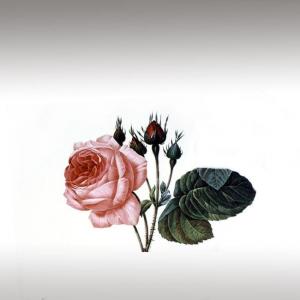

Botanical Name: Rosa centifolia
Common Method of Extraction: Solvent Extracted Absolute
Part Typically Used: The petals of various types of rose
Color: Light to medium yellowish-green slightly viscous liquid
Consistency: Slightly viscous liquid
Perfumery Note: Middle
Strength of Initial Aroma: Voluptuous, sweet, smooth, with distinct yet subtle honey and green notes and the soft, delicate sweetness of a fresh bouquet of roses.
Rosa centifolia (hundred leaved/petaled rose).Plants of roses for reproduction and breeding of new varieties were imported in the 18th century from Holland and Belgium, where exterior trade with the Orient permitted the importation of new botanical roses from overseas. Born in France in the 16th century from several crossings of botanical roses, Rosa centifolia or "Cabbage Rose" with its hundred petals, was introduced in Grasse for the production of rose essence.
Rose de Mai has a long and revered aromatic history in the Grasse region and was one of the main aromatic essences distilled and extracted there along with Jasmine, Tuberose, Violet, Neroli and Mimosa. In that special Mediterranean environment all the natural elements were found to grow Rose de Mai to perfection. Even today, though the land devoted to its cultivation is greatly reduced from the golden era in the late 19th and early 20th century, Rose de Mai Absolute of France is considered the finest in the world. The flowers are commercially harvested for the production of rose oil, which is commonly used in perfumery.
Individual plants are shrubby in appearance, growing to 1,5–2 m tall, with long drooping canes and greyish green pinnate leaves with 5-7 leaflets. The flowers are round and globular, with numerous thin overlapping petals that are highly scented. They are usually pink, less often white to dark red-purple.
On the average a single bush produces 250 grams of flowers. The harvest takes plant in May, very early morning(from 4-8 AM) before the dew has disappeared from the flowers. One harvester can pick from 4-10 kilos per hour. After collection, the roses should be processed as soon as possible, otherwise they will wither and give a poor yield on extraction.
Absolute extraction :
In the solvent extraction method, the flowers are agitated in a vat with a solvent such as hexane, which draws out the aromatic compounds as well as other soluble substances such as wax and pigments.
The hexane washes over the flowers and removes from them waxes, volatile oil and pigments. The "washing" takes about 10 minutes and then is pumped off. This process is repeated three times. The three extracts are then collected together and subjected to vacuum distillation which removes the hexane from the solution leaving behind the odiferous waxy concrete. The hexane is saved for future extractions.
To obtain the absolute the concrete is dissolved in warm alcohol and subjected to chilling so that the nonalcohol soluble pigments and waxes precipitate out. The solution is then filtered and subjected to vacuum distillation to remove the alcohol from the solution, leaving behind the absolute.
It takes about 400-500 kilos of Rosa centifolia flowers to make 2,2 lbs of concrete and from the concrete one obtains 1,1 pound of absolute.
Common Method of Extraction: Solvent Extracted Absolute
Part Typically Used: The petals of various types of rose
Color: Light to medium yellowish-green slightly viscous liquid
Consistency: Slightly viscous liquid
Perfumery Note: Middle
Strength of Initial Aroma: Voluptuous, sweet, smooth, with distinct yet subtle honey and green notes and the soft, delicate sweetness of a fresh bouquet of roses.
Rosa centifolia (hundred leaved/petaled rose).Plants of roses for reproduction and breeding of new varieties were imported in the 18th century from Holland and Belgium, where exterior trade with the Orient permitted the importation of new botanical roses from overseas. Born in France in the 16th century from several crossings of botanical roses, Rosa centifolia or "Cabbage Rose" with its hundred petals, was introduced in Grasse for the production of rose essence.
Rose de Mai has a long and revered aromatic history in the Grasse region and was one of the main aromatic essences distilled and extracted there along with Jasmine, Tuberose, Violet, Neroli and Mimosa. In that special Mediterranean environment all the natural elements were found to grow Rose de Mai to perfection. Even today, though the land devoted to its cultivation is greatly reduced from the golden era in the late 19th and early 20th century, Rose de Mai Absolute of France is considered the finest in the world. The flowers are commercially harvested for the production of rose oil, which is commonly used in perfumery.
Individual plants are shrubby in appearance, growing to 1,5–2 m tall, with long drooping canes and greyish green pinnate leaves with 5-7 leaflets. The flowers are round and globular, with numerous thin overlapping petals that are highly scented. They are usually pink, less often white to dark red-purple.
On the average a single bush produces 250 grams of flowers. The harvest takes plant in May, very early morning(from 4-8 AM) before the dew has disappeared from the flowers. One harvester can pick from 4-10 kilos per hour. After collection, the roses should be processed as soon as possible, otherwise they will wither and give a poor yield on extraction.
Absolute extraction :
In the solvent extraction method, the flowers are agitated in a vat with a solvent such as hexane, which draws out the aromatic compounds as well as other soluble substances such as wax and pigments.
The hexane washes over the flowers and removes from them waxes, volatile oil and pigments. The "washing" takes about 10 minutes and then is pumped off. This process is repeated three times. The three extracts are then collected together and subjected to vacuum distillation which removes the hexane from the solution leaving behind the odiferous waxy concrete. The hexane is saved for future extractions.
To obtain the absolute the concrete is dissolved in warm alcohol and subjected to chilling so that the nonalcohol soluble pigments and waxes precipitate out. The solution is then filtered and subjected to vacuum distillation to remove the alcohol from the solution, leaving behind the absolute.
It takes about 400-500 kilos of Rosa centifolia flowers to make 2,2 lbs of concrete and from the concrete one obtains 1,1 pound of absolute.
Submitted by OperaDreamhouse (March 12, 2014)
Tea Rose Essential Oil (Rosa Odorata) ☸ Essential oils ☸ Base / General
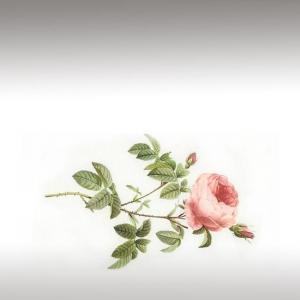

Botanical Name: Rosa odorata
Common Method of Extraction: Solvent Extracted Absolute
Part Typically Used: Flowers
Color: Pale golden
Consistency: Thin
Perfumery Note: Middle
Strength of Initial Aroma: Soft, green, ambery, roseaceous bouquet with a delicate warm pungent, spicy undertone.
Rosa odorata cultivated in China and introduced to Europe in the 1800s, having fragrant tea-scented yellowish or pink flowers.
The name 'Tea rose' is the result of a misunderstanding - the rose was created in the Fa Tee nursery near Canton in China. In 1810 it was discovered by an Englishman who sent a specimen to England. It is the ancestor behind several yellow and yellowish modern roses.
However, the scent of these roses is rather different from that of traditional roses. Surprisingly, their scent is strongly influenced by the aromatic compound orcinyl dimethyl ether, or 3,5-dimethoxy-toluene, which is chemically related to the oakmoss odorants. This phenol ether has a warm and sweet, nut-like, earthy-mossy odour - according to Arctander.
Immediately upon their introduction in the early 19th-century breeders went to work with them, especially in France, crossing them first with China roses and then with Bourbons and Noisettes. The Tea roses are repeat-flowering roses, named for their fragrance being reminiscent of Chinese Black Tea (although this is not always the case).
The colour range includes pastel shades of white, pink and (a novelty at the time) yellow to apricot. The individual flowers of many cultivars are semi-pendent and nodding, due to weak flower stalks. In a "typical" Tea, pointed buds produce high-centred blooms which unfurl in a spiral fashion, and the petals tend to roll back at the edges, producing a petal with a pointed tip. The Teas are thus the originators of today is "classic" florists" rose form.
According to rose historian Brent Dickerson, the Tea classification owes as much to marketing as to botany. 19th-century nurserymen would label their Asian-based cultivars as "Teas" if they possessed the desirable Tea flower form, and "Chinas" if they did not. Like the Chinas, the Teas are not hardy in colder climates.
Rose absolute oil has high levels of antioxidant, vitamin C, tocopherols, phenolics and beta carotenes.
Common Method of Extraction: Solvent Extracted Absolute
Part Typically Used: Flowers
Color: Pale golden
Consistency: Thin
Perfumery Note: Middle
Strength of Initial Aroma: Soft, green, ambery, roseaceous bouquet with a delicate warm pungent, spicy undertone.
Rosa odorata cultivated in China and introduced to Europe in the 1800s, having fragrant tea-scented yellowish or pink flowers.
The name 'Tea rose' is the result of a misunderstanding - the rose was created in the Fa Tee nursery near Canton in China. In 1810 it was discovered by an Englishman who sent a specimen to England. It is the ancestor behind several yellow and yellowish modern roses.
However, the scent of these roses is rather different from that of traditional roses. Surprisingly, their scent is strongly influenced by the aromatic compound orcinyl dimethyl ether, or 3,5-dimethoxy-toluene, which is chemically related to the oakmoss odorants. This phenol ether has a warm and sweet, nut-like, earthy-mossy odour - according to Arctander.
Immediately upon their introduction in the early 19th-century breeders went to work with them, especially in France, crossing them first with China roses and then with Bourbons and Noisettes. The Tea roses are repeat-flowering roses, named for their fragrance being reminiscent of Chinese Black Tea (although this is not always the case).
The colour range includes pastel shades of white, pink and (a novelty at the time) yellow to apricot. The individual flowers of many cultivars are semi-pendent and nodding, due to weak flower stalks. In a "typical" Tea, pointed buds produce high-centred blooms which unfurl in a spiral fashion, and the petals tend to roll back at the edges, producing a petal with a pointed tip. The Teas are thus the originators of today is "classic" florists" rose form.
According to rose historian Brent Dickerson, the Tea classification owes as much to marketing as to botany. 19th-century nurserymen would label their Asian-based cultivars as "Teas" if they possessed the desirable Tea flower form, and "Chinas" if they did not. Like the Chinas, the Teas are not hardy in colder climates.
Rose absolute oil has high levels of antioxidant, vitamin C, tocopherols, phenolics and beta carotenes.
Submitted by OperaDreamhouse (March 12, 2014)
Summer Damasks / Gulab Rose (Roses Gallica x R. Phoenicea Hybrid) ☸ Essential oils ☸ Base / General
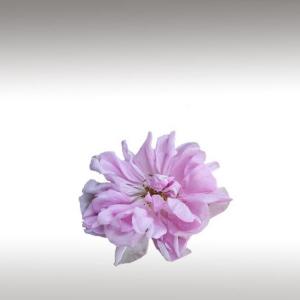

Botanical Name: Rose gallica x R. Phoenicea hybrid
Botanical Origin: Persia
Common Method of Extraction: Rose Attar (Itr) - rose distilled into Sandalwood essential oil.
Distillation Type: Rose petals distilled into Sandalwood essential oil.
Part Typically Used: Petals
Color: Light yellow in colour, sometimes possessing a green tint
Consistency: When cooled, it congeals to a translucent soft mass, which is again liquefied by the warmth of the hand. The congealing point lies between 15 degrees and 22 degrees, mostly between 17 degrees and 21 degrees
Perfumery Note: Top / Middle
Strength of Initial Aroma: Strong odour of fresh Roses. Sweet and floral, deep. Warms with its sweet, heavy core note.
Blends Well With: Jasmine, Vetiver, Ylang-Ylang, Carnation, Neroli, Vanilla and Geranium essential oil.
Common name: French Rose, Gallica Rose, Gallic Rose, GULAB Rose (India), Summer Damasks, Rose of Provins.
Chemical structure: Geranic Acid (Suspected of having an analgesic property. Very little current data available).
Geraniol (A terpene alcohol. Fragrant and regarded as highly valued oil in aromatherapy and the perfume industry. Terpene alcohols are antimicrobial but are a lot gentler on the skin than the phenols).
Nerol (A terpene alcohol).
Terpene Alcohol (Valued for their fragrance, gentle reaction on the skin and membranes and healing properties Terpene Alcohols have earned the name of "Friendly Molecules". Alcohols are amongst the strongest antimicrobial compounds in essential oils but lack the irritant properties of other antimicrobial constituents like phenols).
Citronellal and Citronellol (Citronellal a Terpene Aldehyde and Citronellol a Terpene Alcohol. Fragrant and regarded as highly valued oil in aromatherapy and the perfume industry. Terpene alcohols are antimicrobial but are a lot gentler on the skin than the phenols. Citronellal from Citronella grass has a more pungent smell and is less gentle on skin. Aldehydes are sedative, antiviral and antimicrobial but can be an irritant to the skin).
Geraniol (A terpene alcohol. Fragrant and regarded as highly valued oil in aromatherapy and the perfume industry. Terpene alcohols are antimicrobial but are a lot gentler on the skin than the phenols).
Eugenol (Anaesthetic, antimicrobal, disinfecting, stimulant, aromatic and anticonvulsant.Eugenol is a Phenylpropanoid in the Phenols group. Eugenol is widely distributed in the plant kingdom.Potentially irritant. Sensitivity should be tested before using this substance or oil on the skin).
Monoterpenes (One of the many terpenes, monoterpenes (the smallest of the terpenes, although one of the most widely occurring) are mostly found in essential or volatile oils. Aromatherapists use monoterpenes as a mucus membrane tonic as decongestants and to ease nasal and other mucus membrane discomfort. Monoterpenes evaporate easily and have a low boiling point. Monoterpenes are mostly colorless and odorless, prone to oxidation. Oxidants from monoterpenes could be irritant.Monoterpenes are antiseptic, antiviral and bactericidal),
Note: Essential oil and Atar extracted differently should not mix these concepts, but this two substances you can mixed with each other (if you making your own perfume).
Rosa Gallica, also known as the French Rose, is believed to be indigenous to Iran where these species have been cultivated since time immemorial.
The cultivation of the Rose probably started in ancient times in Persia.
Rosa Gallica (Gallic Rose, French Rose, or Rose of Provins) is a species of flowering plant in the Rose family, native to southern and central Europe eastwards to Turkey and the Caucasus.
The variety of Rosa Gallica Officinalis that is cultivated in many regions across the globe is also known as Apothecary's Rose.
The Gallicas are probably the oldest of all garden Roses. They were grown by the Greeks and Romans.
In the 17th century the Dutch started to breed new varieties, and later the French continued their development on a very large scale. Among them are to be found some very fine Roses with magnificent mixtures of colour - particularly among the crimson, purple and mauve shades - and they have beautiful flower formation.
Plants of this species are deciduous shrubs that often grow up to 1,5 meters in height. Although Roses of this species have developed naturally over several centuries into the plants we are now familiar with, they were first developed by breeders during the early 1800's. Plants belonging to this family of Roses have even stalks bearing piercing thorns. The stems of the plants possess spikes and bristles with glands. The edges of the leaves are jagged like a saw and each leaf has three to seven pairs of leaflets that are bluish-green. These deciduous shrubs cover a large area forming a green covering. The flowers appear in bunches of one to four, while each flower has five single petals that are aromatic and profoundly pink in hue. The hips resemble globes or have an ovoid shape and vary in diameter between 10 mm and 13 mm. Their color ranges from orange to brownish.
People who are involved with aromatherapy utilize the Rose as a mild tranquilizer, anti-depressant and also to cure inflammations or tenderness.
Several researches have established that the petals of the Rose and the preparations with them are similar. In addition to the therapeutic uses of the Rose mentioned above, the petals of the flower and medicines prepared with them have proved to lower elevated cholesterol levels in our bloodstream.
Conversely, Rosewater is mildly caustic or astringent by nature and hence, it is incorporated as an important element for preparing a cream that is used to heal swelling as well as eye pains.
The Rose has always been a symbol of love and over the centuries many marriages have been celebrated with scattered Rose Petals and romantic Rose Petal baths.
The Rose Blossom’s distillate was used to prepare Rosewater, Rose Vinegar andperfume.
What is Rose Attar and how it is born:
True Attar distilled in large clay containers a lot of manual labor and a large knowledge of substances efficiently. Distillation Attar depending on the kind of takes from three months to two years. Sometimes Attari distilled in Sandalwood oil, and sometimes the flowers are distillating together with Sandalwood powder and chips slowly distilled in the same clay or copper boiler.
Sandalwood oil acts as a fixative and a kind of receptacle extremely fragile and unstable floral aromas. Sandalwood aroma is total aromatics quintessence - quality Sandalwood smells like "emptiness", covering all faktors spaces. Sandalwood aroma protects and cares, but does not impose himself .
Comprised of traditional Indian Rose Attar. Roses are placed in copper distilling vessels where they sit in heated water. Vapors pass over into a receiving vessel containing Sandalwood oil, which absorbs the Rose essence over a period of 20 days or 2 months or 2 years. New flowers are distilled each day.
Enchanting and captivating with the scent of Rose Gulab "Regal Queen of Flowers" shimmering above a grove of Sandalwood a lit with Oud.
Botanical Origin: Persia
Common Method of Extraction: Rose Attar (Itr) - rose distilled into Sandalwood essential oil.
Distillation Type: Rose petals distilled into Sandalwood essential oil.
Part Typically Used: Petals
Color: Light yellow in colour, sometimes possessing a green tint
Consistency: When cooled, it congeals to a translucent soft mass, which is again liquefied by the warmth of the hand. The congealing point lies between 15 degrees and 22 degrees, mostly between 17 degrees and 21 degrees
Perfumery Note: Top / Middle
Strength of Initial Aroma: Strong odour of fresh Roses. Sweet and floral, deep. Warms with its sweet, heavy core note.
Blends Well With: Jasmine, Vetiver, Ylang-Ylang, Carnation, Neroli, Vanilla and Geranium essential oil.
Common name: French Rose, Gallica Rose, Gallic Rose, GULAB Rose (India), Summer Damasks, Rose of Provins.
Chemical structure: Geranic Acid (Suspected of having an analgesic property. Very little current data available).
Geraniol (A terpene alcohol. Fragrant and regarded as highly valued oil in aromatherapy and the perfume industry. Terpene alcohols are antimicrobial but are a lot gentler on the skin than the phenols).
Nerol (A terpene alcohol).
Terpene Alcohol (Valued for their fragrance, gentle reaction on the skin and membranes and healing properties Terpene Alcohols have earned the name of "Friendly Molecules". Alcohols are amongst the strongest antimicrobial compounds in essential oils but lack the irritant properties of other antimicrobial constituents like phenols).
Citronellal and Citronellol (Citronellal a Terpene Aldehyde and Citronellol a Terpene Alcohol. Fragrant and regarded as highly valued oil in aromatherapy and the perfume industry. Terpene alcohols are antimicrobial but are a lot gentler on the skin than the phenols. Citronellal from Citronella grass has a more pungent smell and is less gentle on skin. Aldehydes are sedative, antiviral and antimicrobial but can be an irritant to the skin).
Geraniol (A terpene alcohol. Fragrant and regarded as highly valued oil in aromatherapy and the perfume industry. Terpene alcohols are antimicrobial but are a lot gentler on the skin than the phenols).
Eugenol (Anaesthetic, antimicrobal, disinfecting, stimulant, aromatic and anticonvulsant.Eugenol is a Phenylpropanoid in the Phenols group. Eugenol is widely distributed in the plant kingdom.Potentially irritant. Sensitivity should be tested before using this substance or oil on the skin).
Monoterpenes (One of the many terpenes, monoterpenes (the smallest of the terpenes, although one of the most widely occurring) are mostly found in essential or volatile oils. Aromatherapists use monoterpenes as a mucus membrane tonic as decongestants and to ease nasal and other mucus membrane discomfort. Monoterpenes evaporate easily and have a low boiling point. Monoterpenes are mostly colorless and odorless, prone to oxidation. Oxidants from monoterpenes could be irritant.Monoterpenes are antiseptic, antiviral and bactericidal),
Note: Essential oil and Atar extracted differently should not mix these concepts, but this two substances you can mixed with each other (if you making your own perfume).
Rosa Gallica, also known as the French Rose, is believed to be indigenous to Iran where these species have been cultivated since time immemorial.
The cultivation of the Rose probably started in ancient times in Persia.
Rosa Gallica (Gallic Rose, French Rose, or Rose of Provins) is a species of flowering plant in the Rose family, native to southern and central Europe eastwards to Turkey and the Caucasus.
The variety of Rosa Gallica Officinalis that is cultivated in many regions across the globe is also known as Apothecary's Rose.
The Gallicas are probably the oldest of all garden Roses. They were grown by the Greeks and Romans.
In the 17th century the Dutch started to breed new varieties, and later the French continued their development on a very large scale. Among them are to be found some very fine Roses with magnificent mixtures of colour - particularly among the crimson, purple and mauve shades - and they have beautiful flower formation.
Plants of this species are deciduous shrubs that often grow up to 1,5 meters in height. Although Roses of this species have developed naturally over several centuries into the plants we are now familiar with, they were first developed by breeders during the early 1800's. Plants belonging to this family of Roses have even stalks bearing piercing thorns. The stems of the plants possess spikes and bristles with glands. The edges of the leaves are jagged like a saw and each leaf has three to seven pairs of leaflets that are bluish-green. These deciduous shrubs cover a large area forming a green covering. The flowers appear in bunches of one to four, while each flower has five single petals that are aromatic and profoundly pink in hue. The hips resemble globes or have an ovoid shape and vary in diameter between 10 mm and 13 mm. Their color ranges from orange to brownish.
People who are involved with aromatherapy utilize the Rose as a mild tranquilizer, anti-depressant and also to cure inflammations or tenderness.
Several researches have established that the petals of the Rose and the preparations with them are similar. In addition to the therapeutic uses of the Rose mentioned above, the petals of the flower and medicines prepared with them have proved to lower elevated cholesterol levels in our bloodstream.
Conversely, Rosewater is mildly caustic or astringent by nature and hence, it is incorporated as an important element for preparing a cream that is used to heal swelling as well as eye pains.
The Rose has always been a symbol of love and over the centuries many marriages have been celebrated with scattered Rose Petals and romantic Rose Petal baths.
The Rose Blossom’s distillate was used to prepare Rosewater, Rose Vinegar andperfume.
What is Rose Attar and how it is born:
True Attar distilled in large clay containers a lot of manual labor and a large knowledge of substances efficiently. Distillation Attar depending on the kind of takes from three months to two years. Sometimes Attari distilled in Sandalwood oil, and sometimes the flowers are distillating together with Sandalwood powder and chips slowly distilled in the same clay or copper boiler.
Sandalwood oil acts as a fixative and a kind of receptacle extremely fragile and unstable floral aromas. Sandalwood aroma is total aromatics quintessence - quality Sandalwood smells like "emptiness", covering all faktors spaces. Sandalwood aroma protects and cares, but does not impose himself .
Comprised of traditional Indian Rose Attar. Roses are placed in copper distilling vessels where they sit in heated water. Vapors pass over into a receiving vessel containing Sandalwood oil, which absorbs the Rose essence over a period of 20 days or 2 months or 2 years. New flowers are distilled each day.
Enchanting and captivating with the scent of Rose Gulab "Regal Queen of Flowers" shimmering above a grove of Sandalwood a lit with Oud.
Submitted by OperaDreamhouse (March 12, 2014)
Summer Damasks / Gulab Rose (Roses Gallica x R. Phoenicea Hybrid) ☸ Essential oils ☸ Medicine / Health


Therapeutic Properties :
Diuretic
Hepatic
Antiphlogistic
Sedative
Antispasmodic
Tonic
Antibacterial
Antiseptic
Uplifting
Fields of application:.Mature Skin Tonic, Irregular periods, Aphrodisiac, Premenstrual tension, Impotence, Frigidity, Broken capillaries,
Contraindications : There is no information.
Pregnancy / Lactation: There is no information. The smell of this oil is reflects everything what is feminine, maternal, so do not be afraid the small amount of this oil in pregnancy or lactation period.
Children: 2 - 3 years
Guidelines: Sometimes you do not even dilute, just slide your finger over the bottle here is containing the fragrant oil.
Rosa Gallica flower oil derives from the Rosa Gallica plant, known for its beauty and sweet-smelling scent.
In Arabian history distillation of Rose oil dates back to the 10th century and balms were made from Rosa Gallica to treat respiratory disorders.
Avicenna, an Arabian physician who lived between 980 A.D. and 1037 A.D., was the first to make Rosewater with Rosa Gallica or French Rose.
It is interesting to note that the herbal medicine practitioners recommended the use of Rose during the Middle Ages and also during the Renaissance to cure depression as well as sadness.
The essential oil (Attar) extracted from the Rose Blooms is widely utilized in perfume making. In addition, this essential oil also forms an important ingredient in formulations that are added in skincare lotions and lukewarm bath water for treating skin problems. Apart from the essential oil extracted from the flowers, even Rose Water is used in skin care and bath water formulations.
Rose oil (Attar) has a pleasantly calming, balancing and harmonising effect on your mental state. After a stressful day, the scent of Rose Gallica caresses your mind and helps it relax. A drop of Rose oil added to a Scent Lamp has a calming effect on stressed out school kids.
Rosa Gallica flower essential oil (Attar) is a very beneficial external tonic that can be used to sooth and calm irritated skin, reduce wrinkles, heal bruises faster, or as a general skin care product.
Used in this way, it can also treat eczema, acne and shingles and will strengthen and help heal capillaries.
It is also an effective anti-bacterial agent when applied externally.
Diuretic
Hepatic
Antiphlogistic
Sedative
Antispasmodic
Tonic
Antibacterial
Antiseptic
Uplifting
Fields of application:.Mature Skin Tonic, Irregular periods, Aphrodisiac, Premenstrual tension, Impotence, Frigidity, Broken capillaries,
Contraindications : There is no information.
Pregnancy / Lactation: There is no information. The smell of this oil is reflects everything what is feminine, maternal, so do not be afraid the small amount of this oil in pregnancy or lactation period.
Children: 2 - 3 years
Guidelines: Sometimes you do not even dilute, just slide your finger over the bottle here is containing the fragrant oil.
Rosa Gallica flower oil derives from the Rosa Gallica plant, known for its beauty and sweet-smelling scent.
In Arabian history distillation of Rose oil dates back to the 10th century and balms were made from Rosa Gallica to treat respiratory disorders.
Avicenna, an Arabian physician who lived between 980 A.D. and 1037 A.D., was the first to make Rosewater with Rosa Gallica or French Rose.
It is interesting to note that the herbal medicine practitioners recommended the use of Rose during the Middle Ages and also during the Renaissance to cure depression as well as sadness.
The essential oil (Attar) extracted from the Rose Blooms is widely utilized in perfume making. In addition, this essential oil also forms an important ingredient in formulations that are added in skincare lotions and lukewarm bath water for treating skin problems. Apart from the essential oil extracted from the flowers, even Rose Water is used in skin care and bath water formulations.
Rose oil (Attar) has a pleasantly calming, balancing and harmonising effect on your mental state. After a stressful day, the scent of Rose Gallica caresses your mind and helps it relax. A drop of Rose oil added to a Scent Lamp has a calming effect on stressed out school kids.
Rosa Gallica flower essential oil (Attar) is a very beneficial external tonic that can be used to sooth and calm irritated skin, reduce wrinkles, heal bruises faster, or as a general skin care product.
Used in this way, it can also treat eczema, acne and shingles and will strengthen and help heal capillaries.
It is also an effective anti-bacterial agent when applied externally.
Submitted by OperaDreamhouse (March 12, 2014)
Summer Damasks / Gulab Rose (Roses Gallica x R. Phoenicea Hybrid) ☸ Essential oils ☸ Spiritual Practises


Applying Rose Attar to the body and Chakras can calm the nerves, redirect thinking and set the tone for mindful meditation.
An emotional and physical harmonizer, Rose Attar oil is extremely useful during times of mourning and extreme grief since it makes highs and lows more bearable.
Cooling astringent properties are known to alleviate tension, lighten the weight of heavy thoughts, and invite an overall essence of purity and sensuality.
An emotional and physical harmonizer, Rose Attar oil is extremely useful during times of mourning and extreme grief since it makes highs and lows more bearable.
Cooling astringent properties are known to alleviate tension, lighten the weight of heavy thoughts, and invite an overall essence of purity and sensuality.
Submitted by OperaDreamhouse (March 12, 2014)
White Champaca Essential Oil (Magnolia x Alba) ☸ Essential oils ☸ Base / General
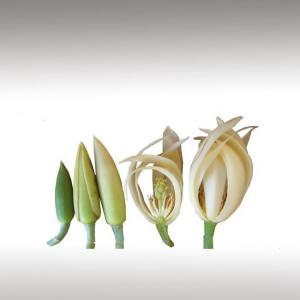

Botanical Name: Magnolia × alba
Common Method of Extraction: Steam Distillation
Part Typically Used: Blossom
Color: Pale green in hue
Consistency: Medium
Perfumery Note: Top
Strength of Initial Aroma: Light, fruity-floral with sweet buttery undertones, a little sharp edge, intensely green and herbaceaous.
There are more than 200 different species and it is not easy to discern exactly which is which. The plant is considered to originate in Central Asia, the Americas and West Indies. In the Himalayas, China and Japan it has a long history of use in traditional medicine. Later it was brought to many other countries and continents to finally be introduced to Europe in the 17th century. Magnolia is believed to be one of the most ancient flowering plants, fossilized specimens have been dated as far back as 95 million years. The tree existed well before the bee and pollination was, and still is to a degree, done by beetles.
White Champaca, the leaves, flowers, and form of which resemble Magnolia, but the blossoms off Michelia generally form clusters among the leaves, rather than singly at the branch ends as Magnolia does. It does belong to the Magnolia family. It is sometimes known as Michelia Alba or White Sandalwood. Magnolia (Michelia x Alba) is a cross between Magnolia champaca and Magnolia Montana, with a fragrance similar to Magnolia champaca. It is a tall, evergreen tree with creamy white flowers.
The essential oil of Magnolia comes mainly from China. Michelia x alba (also called “White champaca”, “White Jade Orchid Tree”, “Bai Yu Lau”) and Magnolia fargesii are the main species, from which the flowers are distilled. The flowers are picked at night, when the scent is at its peak and the scent is absolutely divine. The flowers start emitting the perfume early in the morning, the fragrance becoming more intense during late afternoon and by night fills in the entire space around.
Magnolia × alba matures to 30 meters with evergreen leaves. The flowers have a count of 12 sepals. Magnolia × alba is widely cultivated as an ornamental in Asia, particularly tropical and subtropical regions of China and Southeast Asia for the strongly fragrant flowers. Plant magnolias in full sun or partial shade. The more sun light, the more flower production, but many species are subject to leaf sunburn in hot areas. Most magnolias prefer full sun.
An essential oil is extracted from the flowers. In China, where it is known as bai lan, the flowers are used to prepare yulan tea. Michelia x Alba is a symbol of one of the largest cities in the world Shanghai, the Capital of economic zone of China.
Owing to its exotic and beautiful fragrance, the flower extract is used as a primary ingredient in various most expensive perfumes of the world.
Common Method of Extraction: Steam Distillation
Part Typically Used: Blossom
Color: Pale green in hue
Consistency: Medium
Perfumery Note: Top
Strength of Initial Aroma: Light, fruity-floral with sweet buttery undertones, a little sharp edge, intensely green and herbaceaous.
There are more than 200 different species and it is not easy to discern exactly which is which. The plant is considered to originate in Central Asia, the Americas and West Indies. In the Himalayas, China and Japan it has a long history of use in traditional medicine. Later it was brought to many other countries and continents to finally be introduced to Europe in the 17th century. Magnolia is believed to be one of the most ancient flowering plants, fossilized specimens have been dated as far back as 95 million years. The tree existed well before the bee and pollination was, and still is to a degree, done by beetles.
White Champaca, the leaves, flowers, and form of which resemble Magnolia, but the blossoms off Michelia generally form clusters among the leaves, rather than singly at the branch ends as Magnolia does. It does belong to the Magnolia family. It is sometimes known as Michelia Alba or White Sandalwood. Magnolia (Michelia x Alba) is a cross between Magnolia champaca and Magnolia Montana, with a fragrance similar to Magnolia champaca. It is a tall, evergreen tree with creamy white flowers.
The essential oil of Magnolia comes mainly from China. Michelia x alba (also called “White champaca”, “White Jade Orchid Tree”, “Bai Yu Lau”) and Magnolia fargesii are the main species, from which the flowers are distilled. The flowers are picked at night, when the scent is at its peak and the scent is absolutely divine. The flowers start emitting the perfume early in the morning, the fragrance becoming more intense during late afternoon and by night fills in the entire space around.
Magnolia × alba matures to 30 meters with evergreen leaves. The flowers have a count of 12 sepals. Magnolia × alba is widely cultivated as an ornamental in Asia, particularly tropical and subtropical regions of China and Southeast Asia for the strongly fragrant flowers. Plant magnolias in full sun or partial shade. The more sun light, the more flower production, but many species are subject to leaf sunburn in hot areas. Most magnolias prefer full sun.
An essential oil is extracted from the flowers. In China, where it is known as bai lan, the flowers are used to prepare yulan tea. Michelia x Alba is a symbol of one of the largest cities in the world Shanghai, the Capital of economic zone of China.
Owing to its exotic and beautiful fragrance, the flower extract is used as a primary ingredient in various most expensive perfumes of the world.
Submitted by OperaDreamhouse (March 12, 2014)
Sandalwood Essential Oil (Santalum Austrocaledonicum) ☸ Essential oils ☸ Base / General
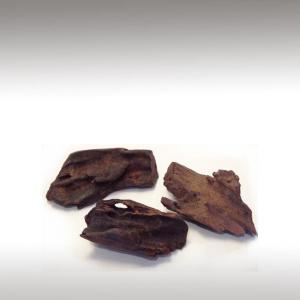

Botanical Name: Santalum austrocaledonicum
Common Method of Extraction: Steam Distilled
Part Typically Used: Heartwood and roots
Color: Pale yellow
Consistency: Slightly viscous liquid
Perfumery Note: Middle/Base
Strength of Initial Aroma: Rich, soft, sweet, creamy, balsamic, smells like precious woods. The heart note is softer and creamier in aromatic texture than the Sandalwood from India and Sri Lanka.
In natural perfumery its application is almost universal as it serves as one of the finest fixatives known in almost all perfume types. It is notably used in high class florals, Oriental bases, precious woods accords, woody-floral bases, fougeres, chypres, sacred perfumes.
Santalum Austrocaledonicum typically grows 5 to 12 metres tall, and around 4 to 8 metres wide. The trees flower after 6 - 7 years, and fruit matures in about 3 months. The trees have gray bark, and short branches bearing light-green leaves. They are considered semi-parasitic in their early stages. Their roots drink the sap of their host plant.
Austrocaledonicum was discovered in 1840 on Pins Island, New Caledonia. In India, many temples were built with its fragrant wood. Some excerpts from the Bible make reference to the use of Sandalwood for the crafting of harps, lutes and railings for the Temple of Jerusalem, in the time of Solomon.
Sandalwood is still today very much used in Hindu ritualsand ceremonies. For instance, it enters in the composition of pastes used in the Temples of Shiva for embalming.
Sandalwood essential oil from New Caledonia is rich in Santalol, the constituent that gives Sandalwood its signature aroma.
The species Santalum Austrocaledonicum, not to be confused with Indian Sandalwood Santalum Album, grows in New Caledonia and Vanuatu. The essential oil distilled from the heartwood is sweet and woody, tinged with warm, milky notes.
Common Method of Extraction: Steam Distilled
Part Typically Used: Heartwood and roots
Color: Pale yellow
Consistency: Slightly viscous liquid
Perfumery Note: Middle/Base
Strength of Initial Aroma: Rich, soft, sweet, creamy, balsamic, smells like precious woods. The heart note is softer and creamier in aromatic texture than the Sandalwood from India and Sri Lanka.
In natural perfumery its application is almost universal as it serves as one of the finest fixatives known in almost all perfume types. It is notably used in high class florals, Oriental bases, precious woods accords, woody-floral bases, fougeres, chypres, sacred perfumes.
Santalum Austrocaledonicum typically grows 5 to 12 metres tall, and around 4 to 8 metres wide. The trees flower after 6 - 7 years, and fruit matures in about 3 months. The trees have gray bark, and short branches bearing light-green leaves. They are considered semi-parasitic in their early stages. Their roots drink the sap of their host plant.
Austrocaledonicum was discovered in 1840 on Pins Island, New Caledonia. In India, many temples were built with its fragrant wood. Some excerpts from the Bible make reference to the use of Sandalwood for the crafting of harps, lutes and railings for the Temple of Jerusalem, in the time of Solomon.
Sandalwood is still today very much used in Hindu ritualsand ceremonies. For instance, it enters in the composition of pastes used in the Temples of Shiva for embalming.
Sandalwood essential oil from New Caledonia is rich in Santalol, the constituent that gives Sandalwood its signature aroma.
The species Santalum Austrocaledonicum, not to be confused with Indian Sandalwood Santalum Album, grows in New Caledonia and Vanuatu. The essential oil distilled from the heartwood is sweet and woody, tinged with warm, milky notes.
Submitted by OperaDreamhouse (March 12, 2014)
Indian lotus Absolute (Nelumbo Nucifera) ☸ Essential oils ☸ Base / General
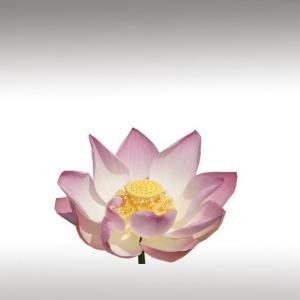

Botanical Name: Nelumbo nucifera
Common Method of Extraction: Food Grade Solvent Extraction. Lotus Absolute in Kampur.
Part Typically Used: Blossoms
Color: Very dark, orange-red
Consistency: Viscous liquid. A molasses-like consistency that may require special use instructions to blend.
Perfumery Note: Top
Strength of Initial Aroma: A honeyed, very intense floral, earthy and somewhat sweet, with ripe-fruit and coumarin-like undertones, a tenacious, deep richness, and a soft yet bold green top note.
Lotus Absolute white and Pink is actually cultivated and extracted in South India. The Pure Lotus Absolute is very nice perfume ingredient.
Nelumbo Nucifera, also known as Indian Lotus, Sacred Lotus, Bean of India, or Simply Lotus, is one of two species of aquatic plant in the family Nelumbonaceae. This plant is an aquatic perennial. Under favorable circumstances its seeds may remain viable for many years, with the oldest recorded Lotus germination being from that of seeds 1,300 years old recovered from a dry lakebed in northeastern China.
The plant normally grows up to a height of about 150 cm and a horizontal spread of up to 3 meters, but some unverified reports place the height as high as over 5 meters. Researchers report that the Lotus has the remarkable ability to regulate the temperature of its flowers to within a narrow range just as humans and other warm blooded animals do.
An individual Lotus can live for over a thousand years and has the rare ability to revive into activity after stasis. In 1994, a seed from a Sacred Lotus, dated at roughly 1,300 years old ± 270 years, was successfully germinated.
The White Lotus, Nelumbo Nucifera is revered as the sacred lotus of Indian, Tibetan, Chinese and Egyptian cultures and is native to India, Tibet and other warm parts of Asia to Australia.
The Lotus plant is cited extensively within Puranic and Vedic literature. Hindus revere it with the divinities Vishnu and Lakshmi often portrayed on a Pink Lotus in iconography. In the representation of Vishnu as Padmanabha (Lotus Navel),a Lotus issues from his navel with Brahma on it.
It is also the national flower of India and Vietnam.
Nelumbo Nucifera flowers are usually obtained through a process of solvent extraction. The resulting oil is so highly concentrated and potent that very small amounts can be used for aromatherapy purposes. Due to the high cost of the extraction process, it is one of the most expensive oil on the market. It's a very expensive absolute it cost around 6000 dollar a kilo.
Absolutes are usually more concentrated than essential oils. Also, the efficiency and low temperature of the extraction process helps prevent damage to the fragrant compounds. With a good understanding of the solvent they are using, extractors can produce absolutes with aromas closer to the original plant product.
The Sacred Lotus (Nelumbo Nucifera) is one of the most important and attractive wetland plant species in India.
Common Method of Extraction: Food Grade Solvent Extraction. Lotus Absolute in Kampur.
Part Typically Used: Blossoms
Color: Very dark, orange-red
Consistency: Viscous liquid. A molasses-like consistency that may require special use instructions to blend.
Perfumery Note: Top
Strength of Initial Aroma: A honeyed, very intense floral, earthy and somewhat sweet, with ripe-fruit and coumarin-like undertones, a tenacious, deep richness, and a soft yet bold green top note.
Lotus Absolute white and Pink is actually cultivated and extracted in South India. The Pure Lotus Absolute is very nice perfume ingredient.
Nelumbo Nucifera, also known as Indian Lotus, Sacred Lotus, Bean of India, or Simply Lotus, is one of two species of aquatic plant in the family Nelumbonaceae. This plant is an aquatic perennial. Under favorable circumstances its seeds may remain viable for many years, with the oldest recorded Lotus germination being from that of seeds 1,300 years old recovered from a dry lakebed in northeastern China.
The plant normally grows up to a height of about 150 cm and a horizontal spread of up to 3 meters, but some unverified reports place the height as high as over 5 meters. Researchers report that the Lotus has the remarkable ability to regulate the temperature of its flowers to within a narrow range just as humans and other warm blooded animals do.
An individual Lotus can live for over a thousand years and has the rare ability to revive into activity after stasis. In 1994, a seed from a Sacred Lotus, dated at roughly 1,300 years old ± 270 years, was successfully germinated.
The White Lotus, Nelumbo Nucifera is revered as the sacred lotus of Indian, Tibetan, Chinese and Egyptian cultures and is native to India, Tibet and other warm parts of Asia to Australia.
The Lotus plant is cited extensively within Puranic and Vedic literature. Hindus revere it with the divinities Vishnu and Lakshmi often portrayed on a Pink Lotus in iconography. In the representation of Vishnu as Padmanabha (Lotus Navel),a Lotus issues from his navel with Brahma on it.
It is also the national flower of India and Vietnam.
Nelumbo Nucifera flowers are usually obtained through a process of solvent extraction. The resulting oil is so highly concentrated and potent that very small amounts can be used for aromatherapy purposes. Due to the high cost of the extraction process, it is one of the most expensive oil on the market. It's a very expensive absolute it cost around 6000 dollar a kilo.
Absolutes are usually more concentrated than essential oils. Also, the efficiency and low temperature of the extraction process helps prevent damage to the fragrant compounds. With a good understanding of the solvent they are using, extractors can produce absolutes with aromas closer to the original plant product.
The Sacred Lotus (Nelumbo Nucifera) is one of the most important and attractive wetland plant species in India.
Submitted by OperaDreamhouse (March 12, 2014)
Neroli Essential Oil (Citrus Aurantium) ☸ Essential oils ☸ Base / General
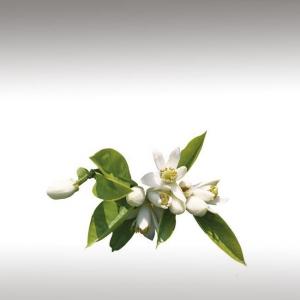

Botanical Name: Citrus aurantium
Common Method of Extraction: Steam Distilled
Part Typically Used: Blossoms
Color: Coffee Brown
Consistency: Medium
Perfumery Note: Base note
Strength of Initial Aroma: Intensely floral, citrusy, sweet and exotic and is appealing to both men and women.
Neroli oil is a plant oil produced from the blossom of the Bitter Orange tree (Citrus Aurantium). As with Lavender, thisessential oil is one of the most popular essential oils.
Orange Blossom is a fragrant distillation of fresh Bitter-Orange flower. This Orange, also known as Sour Orange, is usually too sour to be enjoyed out of hand, but this very same bitterness makes this type of Orange much more aromatic than the rest of the Orange varieties. Almost all parts of Bitter Orange are used to produce beautiful and aromatic materials for the fragrance industry: the essential oil is derived from peel of a fruit, orange leaves are used in production of Petitgrain oil, while delicate white flowers serve in production of Neroli and Orange Blossom absolute.
Neroli originates from Asia, but is now produced all over the world in the Mediterranean, North Africa and China. The oil produced in France and Tunisia is believed to be the finest of them all. The best Neroli oil come from Tunisia, Sicily and France, but the volume from the latter has decreased in the past few years.
Worldwide the annual production does not exceed 2 tonnes. 1 tonne of flowers is needed to produce 1 kg of oil - thus Neroli is highly expensive.
In their favoured Mediterranean or sub-tropical climate, Bitter Oranges can grow to a height of 9 m. It is also known as "Orange Blossom" and it takes about 1000 lbs. of Orange Blossoms to make 1 lb. of Neroli oil.
Although Oranges had been known since the first century, it wasn’t until the late seventeenth century that Neroli oil was discovered.The name is said to have originated from the Italian princess, Anne-Marie de la Tremoille (Countess of Nerola) who used the oil as a perfume and to scent her bathwater and gloves. By the end of the 17th century, Anne Marie Orsini, duchess of Bracciano and princess of Nerola, Italy, introduced the essence of Bitter Orange tree as a fashionable fragrance by using it to perfume her gloves and her bath. Since then, the term "Neroli" has been used to describe this essence.
Neroli has a refreshing and distinctive, spicy aroma with sweet and flowery notes. It is still an ingredient for making traditional smelling eau-de-cologne.
Orange petals are often associated with marriage, purity and brides, as brides traditionally wore Orange buds in their hair.
Orange flowers have been used in wedding traditions since the times of ancient China. In Chinese tradition, orange flowers were omens of purity, innocence and moral virtue, but also a symbol of fruitfulness and fertility. Brides of all nations have always worn some kind of a floral embellishment on their wedding day, and the tradition of using Orange flowers has spread from the East to Europe, during the times of the Crusaders. Maidens have used fresh Orange Blossoms to decorate their hair on a wedding day, and this custom was so widespread that that the expression "to gather Orange Blossoms" took completely different connotation by starting to mean "to seek a wife".
Neroli oil is extracted from the small, white, waxy flowers of the Bitter-Orange tree by steam distillation and yields 0.8 - 1 %. The blossoms are gathered, usually by hand, in late April to early May. The oil is produced by water distillation, as the blossom is too fragile to endure distillation with direct steam.
In perfumery Neroli is used as both a base note and a top note depending on the oils that it is blended with.
Chemical composition:
The main chemical components of Neroli oil are a-pinene, camphene, b-pinene, a-terpinene, nerol, neryl acetate, farnesol, geraniol, linalool, nerolidol, linalyl acetate, methyl anthranilate and indole.
Neroli has an intensely sharp, green and floral aroma, which comes alive when diluted and imparts a refreshing scent.
Common Method of Extraction: Steam Distilled
Part Typically Used: Blossoms
Color: Coffee Brown
Consistency: Medium
Perfumery Note: Base note
Strength of Initial Aroma: Intensely floral, citrusy, sweet and exotic and is appealing to both men and women.
Neroli oil is a plant oil produced from the blossom of the Bitter Orange tree (Citrus Aurantium). As with Lavender, thisessential oil is one of the most popular essential oils.
Orange Blossom is a fragrant distillation of fresh Bitter-Orange flower. This Orange, also known as Sour Orange, is usually too sour to be enjoyed out of hand, but this very same bitterness makes this type of Orange much more aromatic than the rest of the Orange varieties. Almost all parts of Bitter Orange are used to produce beautiful and aromatic materials for the fragrance industry: the essential oil is derived from peel of a fruit, orange leaves are used in production of Petitgrain oil, while delicate white flowers serve in production of Neroli and Orange Blossom absolute.
Neroli originates from Asia, but is now produced all over the world in the Mediterranean, North Africa and China. The oil produced in France and Tunisia is believed to be the finest of them all. The best Neroli oil come from Tunisia, Sicily and France, but the volume from the latter has decreased in the past few years.
Worldwide the annual production does not exceed 2 tonnes. 1 tonne of flowers is needed to produce 1 kg of oil - thus Neroli is highly expensive.
In their favoured Mediterranean or sub-tropical climate, Bitter Oranges can grow to a height of 9 m. It is also known as "Orange Blossom" and it takes about 1000 lbs. of Orange Blossoms to make 1 lb. of Neroli oil.
Although Oranges had been known since the first century, it wasn’t until the late seventeenth century that Neroli oil was discovered.The name is said to have originated from the Italian princess, Anne-Marie de la Tremoille (Countess of Nerola) who used the oil as a perfume and to scent her bathwater and gloves. By the end of the 17th century, Anne Marie Orsini, duchess of Bracciano and princess of Nerola, Italy, introduced the essence of Bitter Orange tree as a fashionable fragrance by using it to perfume her gloves and her bath. Since then, the term "Neroli" has been used to describe this essence.
Neroli has a refreshing and distinctive, spicy aroma with sweet and flowery notes. It is still an ingredient for making traditional smelling eau-de-cologne.
Orange petals are often associated with marriage, purity and brides, as brides traditionally wore Orange buds in their hair.
Orange flowers have been used in wedding traditions since the times of ancient China. In Chinese tradition, orange flowers were omens of purity, innocence and moral virtue, but also a symbol of fruitfulness and fertility. Brides of all nations have always worn some kind of a floral embellishment on their wedding day, and the tradition of using Orange flowers has spread from the East to Europe, during the times of the Crusaders. Maidens have used fresh Orange Blossoms to decorate their hair on a wedding day, and this custom was so widespread that that the expression "to gather Orange Blossoms" took completely different connotation by starting to mean "to seek a wife".
Neroli oil is extracted from the small, white, waxy flowers of the Bitter-Orange tree by steam distillation and yields 0.8 - 1 %. The blossoms are gathered, usually by hand, in late April to early May. The oil is produced by water distillation, as the blossom is too fragile to endure distillation with direct steam.
In perfumery Neroli is used as both a base note and a top note depending on the oils that it is blended with.
Chemical composition:
The main chemical components of Neroli oil are a-pinene, camphene, b-pinene, a-terpinene, nerol, neryl acetate, farnesol, geraniol, linalool, nerolidol, linalyl acetate, methyl anthranilate and indole.
Neroli has an intensely sharp, green and floral aroma, which comes alive when diluted and imparts a refreshing scent.
Submitted by OperaDreamhouse (March 12, 2014)
Page 45 of 48

